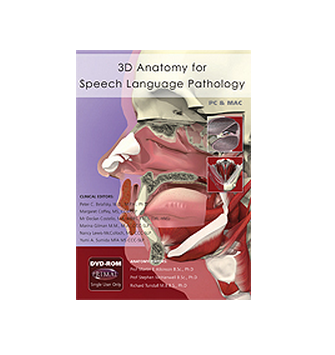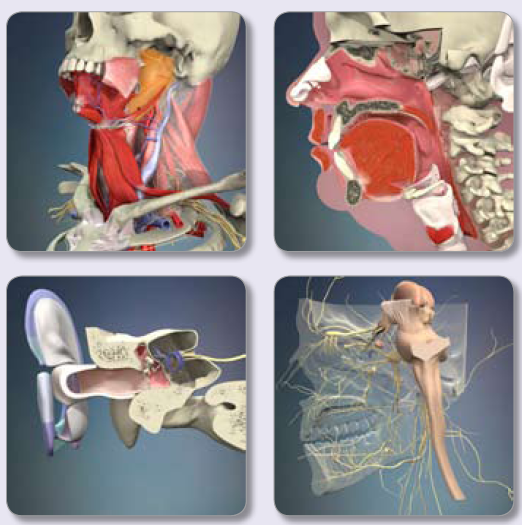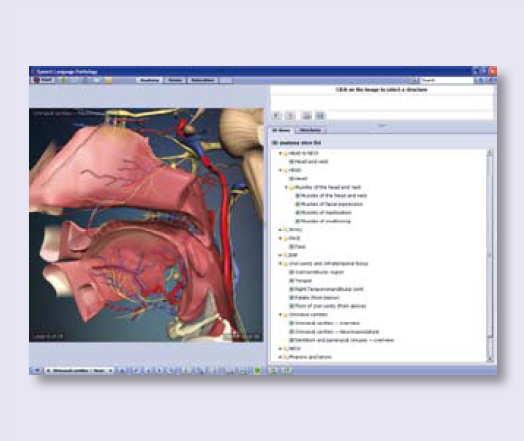- Hundreds of 3D anatomy views cover the anatomy most relevant to you. The anatomy of the head and neck including facial muscles, tongue, oronasal cavities, larynx, pharynx, ear and nerves are included in unsurpassed detail, with supplementary content on basic anatomical
- language and systems of the human body also provided.
- It also contains 3D animations of movements of the face (such as elevation/depression of the corners of the mouth and opening/closing of the lips), movements of the larynx/pharynx, movements of the TMJ and respiration, as well as fantastic 2D animations covering mechanisms of swallowing, mechanisms of articulation and voice, mechanisms of voice production including the mucosal wave and actions of the larynx.
- Clinical content covers normal functional anatomy, with both written descriptions and visual representations of the mechanisms of swallowing, mechanisms of voice production and mechanisms of articulation, as well as topics such as cleft palate, vocal fold paralysis, spasmodic dysphonia, swallowing problems after stroke and swallowing problems after cancer among many others.
- The invaluable patient education section includes useful editable and printable sheets. With patient orientated text and clear, annotated illustrations, each sheet includes an appropriate description of the anatomy and nature of each condition.
3D Anatomy Section:
- Anatomical Language
- Skeletal System
- Muscular system
- Heart – including chambers of the heart
- Brain – including meninges, dural folds and sinuses, ventricles, brainstem, cerebellum, cerebrum, motor and sensory homunculi, basal ganglia, limbic system and vessels
- Spinal cord – including cross section and tracts
- Nervous system – including cervical plexus and brachial plexus
- Respiratory System
- Muscles of facial expression
- Muscles of mastication
- Muscles of swallowing
- Pharynx and larynx – with a collection of 10 new muscle atlas, views covering the muscles of the larynx
- Oral cavities – including tongue, right TMJ, palate, floor of oral cavity, dentition and paranasal sinuses and oronasal cavities
- Abduction/Adduction of the vocal cords
- Sliding of the artenoids
- Rotation of the thyroid
- Cervical fascia
- Cranium – including individual bones
- Ear – including external, middle and inner ear and cochlea cross section
- Cranial nerves – including olfactory nerve, optic nerve, oculomotor nerve, trochlear nerve, trigeminal nerve, abducens nerve, facial nerve, vestibulocochlear nerve, vagus nerve, accessory nerve, hypoglossal nerve
- Surface anatomy
Clinical Section:
Clinical text is provided by a team of clinical authors. The text contains background, clinical presentation and evaluation, adverse impact on function and management for each condition. Topics include normal function (such as mechanisms of swallowing, mechanisms of voice production and mechanisms of articulation). Conditions include hemorrhage, acute laryngitis, vocal fold paralysis, dysphonia,
neoplasms, granuloma, swallowing problems after stroke, swallowing problems after cancer, cleft lip and palate and saccular cysts amongst others.
Patient Education Section:
There is a fantastic patient education section to complement the topics covered in the clinical section. Each sheet is printable and editable and includes background, information on the condition, treatment and advice plus appropriate patient-friendly images and diagrams.
Animation Section:
This section includes relevant 3D animations including those illustrating movements of the face (such as elevation/depression of the corners of the mouth, opening/closure of the lips and pursing of the lips), movements of the larynx/pharynx (such as elevation/depression of the hyoid bone), movements of the TMJ (including elevation/depression, lateral movement and protrusion/retraction) and respiration.
There are also stunning 2D animations of articulation mechanisms, including 24 of consonants and 18 of vowels.
Technical Specification:
Requires an internet connection.
Recommended web browsers:
Internet Explorer 7 + (Windows)
Firefox 2 (on Windows)
Safari (Mac)
Chrome
* Your login and password will be sent you by email on completion of your order.





